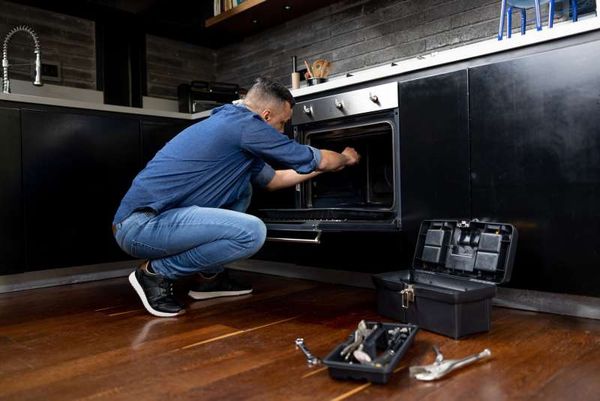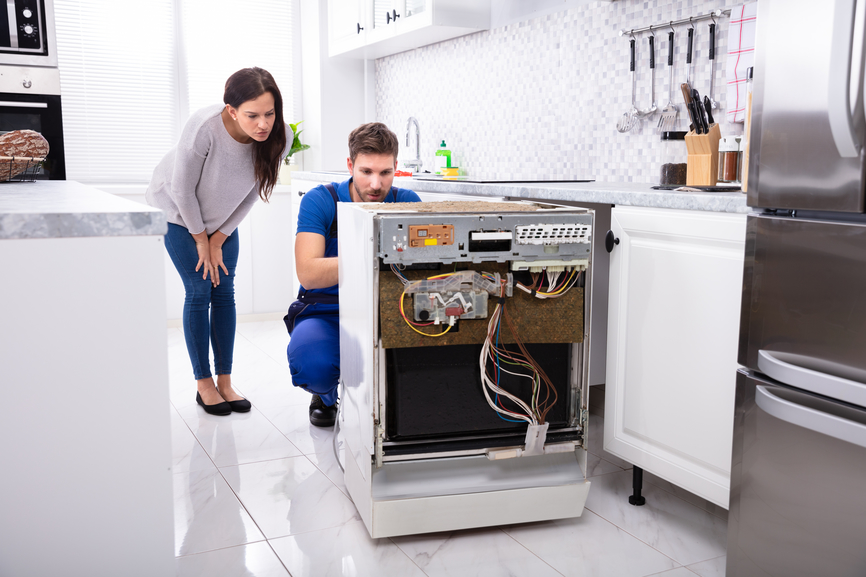The Ultimate Overview to Recognizing Home Appliance Fixing in the house
When your refrigerator quits cooling or your stove refuses to heat, it can feel frustrating. Comprehending device fixing in your home can conserve you time and money. You'll find out to acknowledge signs, utilize crucial tools, and adhere to a systematic troubleshooting procedure. Before you start, there are crucial safety precautions you need to take into account. What are one of the most common problems, and exactly how can you repair them? Let's discover the essentials.
Usual Home Appliance Problems and Their Symptoms
When your appliances start acting up, it's important to acknowledge the indications at an early stage. Overlooking them can lead to bigger issues and costly fixings. If your refrigerator isn't cooling properly, you could discover warm spots or condensation developing. This might suggest a failing compressor or an obstructed vent.Your dishwasher might reveal troubles via dirty recipes or unusual noises during cycles. If you listen to grinding or clanking, it's time to investigate.A washing maker that will not rotate or drain can leave you with soggy laundry, suggesting a clogged drain or a malfunctioning pump.Lastly, if your oven's temperature appears off or it takes forever to pre-heat, you could be handling a faulty thermostat. By remaining sharp to these signs and symptoms, you can deal with concerns before they escalate into major repairs.
Essential Tools for Appliance Repair
When you're dealing with appliance repair work in your home, having the right devices is necessary. Basic hand tools like screwdrivers and pliers will certainly aid you take apart and deal with numerous home appliances, while electrical screening tools ensure you're working safely with wiring. Let's review what you need to get going on your repair service trip.
Basic Hand Devices
Having the right tools is vital for reliable home appliance repair work in the house. Beginning with a reputable screwdriver set, including both flathead and Phillips kinds, as screws are usual in home appliance assembly. Pliers are additionally vital; they assist with gripping, twisting, and cutting cables or little elements. A pair of needle-nose pliers can reach difficult situations quickly. You'll require a good flexible wrench for tightening up or loosening nuts and screws. An utility blade comes in handy for puncturing product packaging or insulation. Lastly, don't forget a tough workbench or surface to securely arrange your devices and components. With these basic hand devices, you'll be well-prepared to take on most appliance repairs that come your method.
Electrical Screening Tools
Together with standard hand tools, electrical screening gadgets play a crucial duty in device repair service. These tools aid you detect electric concerns and assurance appliances operate safely. A multimeter is important; it measures voltage, present, and resistance, enabling you to determine problems promptly. A non-contact voltage tester is another must-have, letting you find real-time wires without making direct get in touch with, improving your safety and security. Clamp meters are excellent for measuring current flow in cables without separating them, saving you effort and time. Furthermore, circuit testers can swiftly examine if outlets are operating effectively. By utilizing these gadgets, you'll streamline your troubleshooting procedure and enhance your repair service skills, making home appliance maintenance a great deal easier.
Step-by-Step Guide to Diagnosing Device Issues
When your appliance breaks down, it can be aggravating, however detecting the problem doesn't need to be frustrating. You'll discover to identify usual issues and apply effective repairing methods. Let's go through the steps to get your device back in working order.
Common Device Troubles

Troubleshooting Methods Explained

Repairing Major Kitchen Appliances: A Closer Look
Have you ever before wondered exactly how to tackle usual problems with your kitchen area home appliances? Fixing major kitchen area appliances like fridges, ovens, and dishwashing machines can be simpler than you assume. Beginning by identifying the problem-- whether it's a fridge not cooling down or a stove that won't heat up. Usually, a straightforward reset or checking the source of power can resolve the issue.For refrigerators, clean the condenser coils and examine the door seals. If your stove's not home heating, inspect the home heating element and thermostat. Dishwashing machines could just need a clean filter or a reset to obtain them back at work. Always unplug the device before diving into repair services to ensure your safety.Don' t fail to remember to speak with the individual handbook for specific fixing suggestions connected to your model. With a little bit of patience and the right devices, you can with confidence deal with appliance repair services and save money in the process!

Fixing Laundry Equipments: Tips and Techniques
When your laundry appliances start acting up, it can feel frustrating, but troubleshooting them doesn't need to be an inconvenience. Beginning by inspecting the power supply. Verify the appliance is connected in and the outlet is functioning. Next off, evaluate the door or cover button; a defective button can avoid the equipment from operating.For washers, if it's not spinning, check for out of balance tons. Redistributing the clothing may resolve the problem. If your clothes dryer isn't home heating, clean the lint filter and check the air vent for blockages.Listen for uncommon sounds; they can show a trouble. If your home appliance is dripping, check the hose pipes for fractures or loose links. File any error codes shown on electronic displays, as they can guide you in recognizing the issue. Consult the user guidebook for details fixing ideas connected to your design.
Security Precautions to Take Throughout Fixes
Before you begin any device repairs, it's vital to prioritize safety to stop accidents or injuries. Unplug the device or transform off the circuit breaker to ensure no power reaches it while you function. Usage insulated tools to decrease the danger of electric shock. Put on safety and security goggles and handwear covers to safeguard yourself from sharp edges or debris (Washer dryer repair service Dependable Refrigeration).Make certain your workspace is clean and well-lit, so you can see what you're doing. Keep kids and family pets away from the area to avoid interruptions and potential dangers. If you're taking care of gas devices, be added careful; look for leakages before proceeding.Take your time, and do not hurry through fixings. If you really feel unpredictable regarding any action, it's much better to pause and research than to presume. Complying with these precautions will certainly assist develop a safer setting for your DIY home appliance fixing job
When to Call a Professional for Assistance
Just how do you know if it's time to call an expert for home appliance fixings? If you've attempted standard troubleshooting without success, it's a clear sign. If your device still will not start or reveals unusual sounds after resetting it, don't hesitate to seek specialist help.When you see leakages, smoke, or shedding smells, focus on security and call a professional instantly. These issues can cause even more substantial damages or position risks to your home.Also, if your home appliance is under service warranty, speaking to a professional is commonly the best route. They can guarantee that fixings won't invalidate your guarantee, conserving you money in the lengthy run.Finally, if you're unclear or uncomfortable with complex repair services, it's important to leave it to the specialists. Keep in mind, taking on complicated issues without the ideal knowledge can result in costly blunders. more info Trust fund an expert when unsure!
Frequently Asked Inquiries
How Can I Avoid Home Appliance Issues in the Future?
To protect against device problems in the future, you need to do routine upkeep, look for deterioration, clean filters, and stay clear of overloading. Remaining positive will help prolong their life expectancy and maintain them running smoothly.
What Are the A Lot Of Typical DIY Home Appliance Repair Work Mistakes?
You might overlook safety preventative measures, avoid repairing steps, or make use of inaccurate tools when attempting do it yourself device repairs. Rushing the process or neglecting producer standards can result in even more substantial concerns and pricey errors. Remain person and educated!
Just how Do I Know if a Component Needs Substitute?
You can tell if a component requires replacement by looking for unusual noises, leakages, or inconsistent efficiency. If the home appliance has a hard time to operate correctly or shows visible damage, it's most likely time for a replacement.
Can I Use Generic Components for Appliance Repair Works?
Yes, you can utilize common parts for home appliance fixings, but identify they work - Dependable Refrigeration & Appliance Repair Service Dryer repair near me. Generic parts may save you money, yet they could influence efficiency or longevity, so evaluate your choices meticulously before making a decision
What Service Warranties Cover Home Appliance Fixes?
Many home appliance warranties cover fixings for manufacturing flaws, however they commonly exclude damage from misuse. Inspect your warranty terms very carefully, as some might need utilizing licensed service technicians and initial components for protection to remain valid.
Comments on “Top 10 Dryer Troubleshooting Tricks – Dryer repair Oro Valley Dependable Refrigeration & Appliance Repair Service”